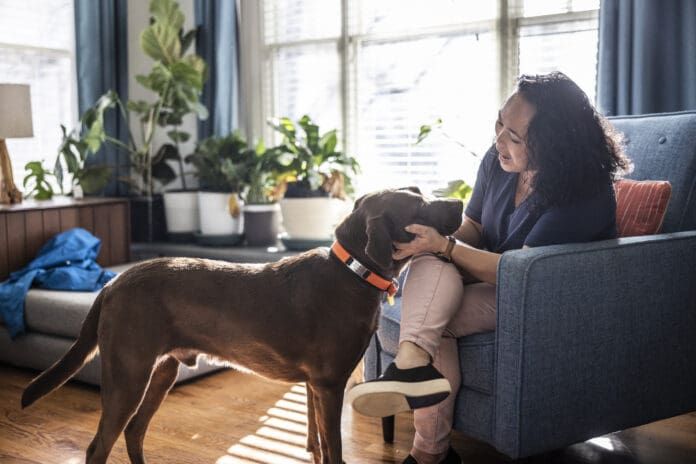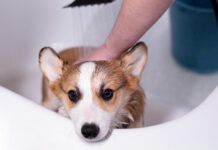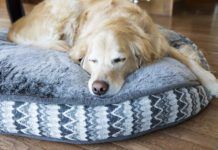At Whole Dog Journal we value our readers and want to help them do their very best for their dogs. We’ve taken your question to the experts in order to provide the best advice for solving your problems with dog behavior and training. In this issue our experts provide advice about separation anxiety in multi-dog households, and how to stop a determined poop eater.
Dealing With Separation Anxiety
My German Shepherd, Mercy, was just a puppy when I got her; now she is three years old. I use a wheelchair, and she is my service dog, so she is almost always with me. But occasionally I do have to leave her. When I go places I leave her in my van by herself, and she is fine with this for any amount of time. If I leave her at home by herself, though, she panics. She’ll even knock over furniture in order to see out the window and to try to get out.
This behavior worsened recently following my move to a new house, which I share with several other people. When I left the other day, she climbed onto the kitchen counter to see out the window (and helped herself to the loaf of bread that was on the counter, something she had never done before), and got up on the dining room table to see out another window, knocking paperwork, candles, flowers, etc. to the floor.
The only thing that has worked in the past is not to leave her alone, but obviously, this is not always practical! A friend of mine suggested putting her in a crate when I’m gone, but she has never been crated before and I’m afraid she might freak out.
Incidentally, there are five other dogs where I am living now, so it’s not like she is all alone when I leave her here!
-Robert Alonzo
Santa Rosa, CA
We gave this question to Jill Breitner, a certified veterinary technician and an animal behaviorist from Sonoma County, CA. Breitner has operated her animal behavior practice, Totally Devoted To You, for 21 years.
Separation anxiety can cause enormous problems for people whose dogs are experiencing it. There are a number of ways this can manifest itself in the dog, and not all solutions are right for each dog. Every case has to be dealt with in an individual manner. The approach I’ll describe below could work in your dog’s case, but other dogs may need a slightly different approach Separation anxiety comes from the dog feeling insecure. It can arise from a number of conditions, many of which might be unknown if you have not had the dog since its birth. There is not a single answer to solving the problem; you really need to put an entire behavior modification program into place.
Often, the first thing inexperienced people will tell you to do is crate a dog who is destructive. Proper early crate training is a great thing to do with young dogs. But crating an adult dog with a history of separation anxiety, one who had never been crated before, would make the dog freak out. I’ve seen panicked dogs who have ripped their pads or nails off trying to get out of a crate, who have suffered heat prostration in their desperation to escape, and who have broken their teeth biting the bars on the door. You were correct to avoid crating Mercy.
Clearly, one step toward the survival of your own house is to confine the dog to a smaller space where she can’t do as much damage or to get into trouble. Select a room that is not too small or confined (a small bathroom, for instance, or a room with no windows); this will only add to her panic. You need to work on building Mercy’s confidence. One easy way to do this is to teach or, in the case of an already trained service dog, review some basic obedience exercises. Set aside at least 10 to 20 minutes a day to work with your dog, going over some basic obedience drills (sit, down, stay, heel, etc.). This will refresh her memory as to some of the keystones of the dog/human relationship. It will remind her who is in charge, what is right and wrong, what her limits are, and that she is a good dog.
Whenever a dog displays signs of stress, as is common when people change locations, it can be helpful to go back to square one in terms of their training, and review some of their familiar territory. Even highly trained working dogs benefit psychologically from the repetition of their most basic skills. Successfully fulfilling your basic requests and receiving praise for a job well done, will help boost her confidence and self-esteem.
Incidentally, even dogs who have had no formal training can benefit from gentle, non-violent training when they are under stress. Daily training sessions guarantee the dog some contact with you, at least 20 minutes a day, one on one. And when they learn things that please you, it makes them feel good about themselves and their situation.
Next, I’d start to wean her from your constant presence, by slowly introducing her to short separations. Some dogs start to panic the moment you walk out the front door, attacking the door as it closes behind you. If that’s the case, these first practice sessions will be short.
Purchase one of those Kong toys (or something similar) to use to distract her when you start your trial separations. I like to use a Kong that has been filled with peanut butter and frozen. This makes the peanut butter even harder to get out quickly. I’d give one to her once in your presence, to make sure she can figure it out and is interested in it, and then refrain from giving her another until your first practice separation.
Since there are other dogs in your household, you might have to give her this toy in a fenced-off room or section of the house. If she seems to benefit from the company of the other dogs, you might want to include them in the anxiety section of the house, and give them their own Kong toys to ensure she’ll have one after you close the door.
By the way, as soon as you come home, pick up the Kong toy, and only give it to her when you leave. You don’t want this to be a treat she learns to under appreciate.
I like to tell my dogs when I leave, I love you; take care of the house. This is just a calm acknowledgment that I’m leaving, and it’s giving them a job to do while I’m away. It’s NOT intended to put them on notice of a big event, like, I’m going away now and I’ll be back in a few hours so don’t worry! Dogs are extremely sensitive to your tone and your underlying nervousness; if you are anxious about leaving her, it helps cue her to be anxious, too.
Sometimes, dogs know you’re not really leaving unless you go through all the motions of really leaving: taking your keys, locking the door, getting in your car, and driving away. Other dogs assume the worst every time you step out the front door, even if you are just in your bathrobe. Use whatever routine it takes to convince your dog you really are leaving; the practice is of no use if she doesn’t believe it’s the real thing.
Depending on her reaction, the first separation can be as little as one minute, or as long as five to 10 minutes. If you come home to a house that is in the same shape as you left it in, you can make your next trial a little longer. Keep extending the length of your sessions, until you are doing what you really need to do when you leave!
What you do when you come back home is important. If you find a scene of devastation, don’t make the mistake of sympathizing with the dog: Oh, poor sweetie, you were so afraid! I’m so sorry! She needs to know that her behavior is not OK. If I came home and saw wreckage, including, as you mentioned, an empty bread bag, I’d go to her and put her on a leash, taking her around the house and showing her all the things she’d done wrong, while talking to her in a very stern, mean tone of voice. I’d do this for at least a minute, but not much longer.
Following the correction, I’d ignore her for at least 15 to 20 minutes. This period is very important in the case of insecure dogs, who, like children, will sometimes do bad things in order to get your attention a negative form of attention, but attention nevertheless. By fussing about her bad behavior for an extended period, you inadvertently give her the attention she craves. Ignoring her helps to punish the behavior instead.
But if you come home and see that she’s been good, don’t make a big fuss over her. Greet her as you would another grown-up person at home: Hi, it’s nice to see you, how was your day? It shouldn’t be a big deal that you left and came back, saying with great excitement, Oh goodness, how I missed you and what a great job you did while I was away! Leaving and coming back is an ordinary event. Hopefully, shell learn this simple truth for herself.
Stopping a Feces Eater
My 2 1/2-year-old Beagle, Brittany, is the most wonderful dog I’ve ever had. She has, however, one disgusting habit. Given the opportunity, she eats her own feces. I have to immediately clean up every poop, or she’ll eat it as soon as she has a chance. She doesn’t do this when we’re out on walks, just at home in our yard. I’ve tried putting aversive agents on it Tabasco, hot sauce, and Bitter Apple but she’ll eat it anyway.
We bought Brittany from a pet store when she was about six months old. She is generally very healthy and active, and I feed her a great dog food, California Natural.
-Jennifer Jimolka
Stamford, CT
We turned over this question to Dr. Nancy Scanlan, a veterinarian for 27 years, the last 10 in an all-holistic practice. Dr. Scanlan, who practices in Riverside, CA, is the author of Stop That Itch!
Some dogs eat feces because they are missing trace minerals in their diet. While California Natural is a good food, your dog may need a trace mineral supplement. I’d try kelp or AniMinerals or any mineral supplement that’s from old sea beds.
Sometimes dogs don’t produce enough digestive enzymes. It seems curious, but these dogs are compelled to eat their feces because it contains the digestive enzymes they need a kind of a disgusting recycling system. I’d also try giving Brittany some digestive enzymes with her food. My favorite brand is ProZyme.
Sometimes, for unknown reasons, dogs get in the habit of eating their feces, and even seem to develop a taste for it; for some reason, this is more common in dogs that come from pet shops. If neither of the two suggestions above seem to stop her, there are a number of things you can add to her food that will change the chemistry and taste of her feces, making it less attractive to her. These additives work better than something you spray or pour on the feces, because the bad taste will permeate the feces, as opposed to simply covering it. Purportedly, these substances are chemically transformed into a much more aversive substance in the digestive tract.
Adding meat tenderizer or raw, grated zucchini to her food is supposed to accomplish this. There are two commercial food additives, Forbid and Deter (the latter is essentially meat tenderizer) available from veterinarians that supposedly alter the chemistry of the feces and make it as repugnant to the dog as it is to us!






